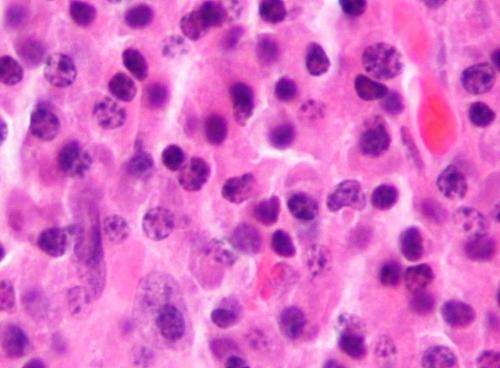This article has been reviewed according to Science X's editorial process and policies. Editors have highlighted the following attributes while ensuring the content's credibility:
fact-checked
peer-reviewed publication
trusted source
proofread
Research group unveils the first individual risk prediction model for multiple myeloma

A multicenter collaboration has produced the first computational model for newly diagnosed multiple myeloma that predicts an individual's personalized prognosis based on their tumor genomics and treatments. The collaboration was led by researchers at Sylvester Comprehensive Cancer Center at the University of Miami Miller School of Medicine
The prediction model for individualized risk in newly diagnosed multiple myeloma, or IRMMa, improves on previous prognostic tools because it takes into account the biology of patients' tumors, said Dr. C. Ola Landgren, chief of the Division of Myeloma and director of the Sylvester Myeloma Institute, senior author of an article unveiling the new tool in the Journal of Clinical Oncology.
This is important in many cancers, but especially in multiple myeloma, which is highly variable. In fact, the researchers identified 12 distinct subtypes of the disease, a classification that had not been made before.
"The future of the field will have to be focused on precision medicine," Landgren said. "There's no other way forward."
The original method for classifying multiple myeloma, developed in the 1970s, was based on staging for solid tumors. It relied on the amount of cancer present, and with the treatments available at the time, it was fairly accurate, Landgren said. But with newly developed therapies, especially immunotherapies, the amount of cancer is often less important than the nature of the cancerous cells.
Different kinds of driver mutations in the tumor genome affect the cancer's growth, so certain subtypes of myeloma could have a very good outcome even if they're diagnosed when the cancer is widespread, assuming the right treatment is matched to the patient.
The number of treatment options for the disease has dramatically expanded in the past two decades, and patients are living longer with the disease. But with so many therapeutic choices, physicians need a way to predict which treatment will work best for each patient.
Dr. Francesco Maura, an assistant professor at Sylvester and first author on the study, said that although prognostic tools have been updated through the years, the field has still lacked precise prediction.
Some tools included tumor genomic features, but there have been recent new findings about genomic risk factors that had not yet been included in a prediction model. And all the tools to date relied on averages of a population, lumping patients into groups like "standard risk" and "high risk" and giving prognoses for those groups overall that didn't take into account individualized risk and how this can be modified by distinct treatments.
"Our model is based on the idea of predicting the risk of the individual patient rather than that of the group," Maura said.
Because it's built using deep learning, IRMMa can learn and improve as it receives more data. The model is built in a manner that allows emerging datasets with future treatment strategies to be added. The research team is now working on including additional datasets from patients treated with newer antibody-based multiple myeloma therapies.
To build the model, the Sylvester researchers and their collaborators used genetic, treatment and clinical data from nearly 2,000 patients newly diagnosed with multiple myeloma. From sequences of the patients' DNA, the scientists first identified 90 "driver genes"—genes bearing mutations in the cancer cells that appear to spur tumor growth.
They then looked at the treatments each patient in their dataset received and how the patients fared on those treatments, matching treatment outcome to an individual's tumor genetic sequences.
The Sylvester team worked with scientists at Memorial Sloan Kettering Cancer Center, NYU Langone Health, Moffitt Cancer Center and Heidelberg University Hospital to amass the patient data. The model is available online for anyone to use, although its current iteration is aimed at researchers rather than clinicians, Maura said. It could be useful for researchers interpreting or designing new clinical trials, for example, to provide a large set of comparisons to the experimental treatment.
Maura and his colleagues also aim to improve the model by integrating more patient data.
"This model can only grow with the help of the research community," Maura said. "The next challenge is to keep feeding it with the right datasets so at a certain point it will be usable for clinical purposes."
IRMMa is also flexible. A patient's prognosis from the model can be changed if, for example, they receive a transplant after a given treatment. When new therapies become available, as long as there is data from at least a few hundred patients, the model can be updated to incorporate those treatments.
While the field isn't quite at the point of sequencing entire tumor genomes for every newly diagnosed patient, that might come in the near future as whole genome sequencing becomes more economical, Landgren said.
"More and more information will become available, and tools like this model are the future for optimized treatment and management," he said.
More information: Genomic Classification and Individualized Prognosis in Multiple Myeloma, Journal of Clinical Oncology (2024).



















